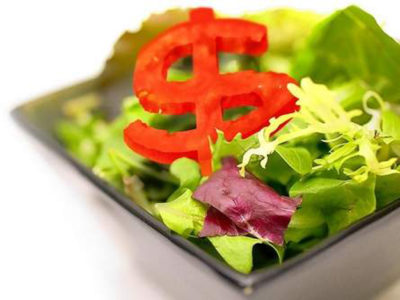|
Listen To The Article
|
 For those that tout it’s just too expensive to eat healthy, a new study sheds some light — and the results may be surprising.
For those that tout it’s just too expensive to eat healthy, a new study sheds some light — and the results may be surprising.
Researchers at the Harvard School of Public Health recently put a price on the cost of a healthy diet. After analyzing 27 studies on the average cost of healthy versus unhealthy diets, they concluded that a so-called “healthy” diet will cost about $1.50 more per day than an unhealthy one. That means that over the course of a year a person will spend $550 more if they choose to eat healthy. When you consider that the average American spends about a $1,000 annually eating out, $550 is a drop in the bucket.
In addition, when you look at the price of health care and hospital visits related to sickness and disease at least partially attributed to poor diet, spending the extra upfront seems like a pretty good idea.
The US spent more than $147 billion in obesity-related health care costs in 2008, while in 2012 more than $245 billion was spent to cover diabetes-related costs. There seems to be no indication that this trend will slow any time soon.
So why does it cost more to eat healthy? One of the main price differences was found among meats. A healthier serving of meat will run you about 29 cents more than a less-healthy cut. Researchers continue to examine the contributing factors; however, they deduce that healthier cuts require better processing techniques while mass-produced lower-end products are cheaper to manufacture, pack and ship. If you opt for the healthiest meat which is organic grass-fed, you will most certainly pay a premium.
New Survival Seed Bank™ Lets You Plant A Full Acre Crisis Garden!
Government subsidies are also to blame for the price discrepancies among food choices. Subsidizing a crop like corn allows for the cheap production of high-fructose corn syrup while another heavily subsidized crop, the soybean, is used in a number of highly processed and unhealthy foods scattered among the inner aisles of our supermarkets. However, healthier fare never sees this government assistance, which keeps its prices at a premium. There has never, for instance, been a subsidy for carrots or avocados — two highly nutritious foods that everyone should be eating on a regular basis. However, neither of these two foods can be stripped of their nutrients and hyper-refined – two things that make them fairly useless to food manufacturers.
Consumer education in the field of just what constitutes “health food” also contributes to the rising costs of the “healthy” diet. Marketers are on to consumers’ growing concerns over nutrition. Many use labeling techniques to make a product sound healthier than it really is…and they charge for it. For example, a claim like “lower-sugar” sounds like a healthy option, when in reality the sugar has been replaced with a dangerous artificial sweetener. Claims like these are strewn across packages and labels and many aren’t worth much. Yet the health-conscious consumer eagerly spends the extra 50 cents or a dollar thinking they’re making a wise choice purchasing the low-fat peanut butter or the diet granola bars.
The Harvard study’s price of $1.50 per day is only an estimate and the researchers themselves note that there are several areas that need more consideration as much of the data was collected from past studies.
Researchers, however, hope the report will nudge policy-makers toward changes that will make healthy real food more affordable for everyone. It may mean granting subsidies for better quality produce or taxing less-nutritious snacks and sodas. Finding ways to make healthy food more available for a wide-range of consumers will be a step in the right direction.
In the meantime, think about shopping for real, unrefined food. Perhaps you will notice that although the price may be a little more than conventional food, you don’t have to buy as much because you no longer have cravings for junk food or have to eat as much to feel full and energized. Generally speaking, the better quality food you eat, the less the body requires to operate optimally. So, make an effort to eat less of the best and see just how great you feel!
Sign up for Off The Grid News’ weekly email and stay informed about the issues important to you
 Off The Grid News Better Ideas For Off The Grid Living
Off The Grid News Better Ideas For Off The Grid Living




